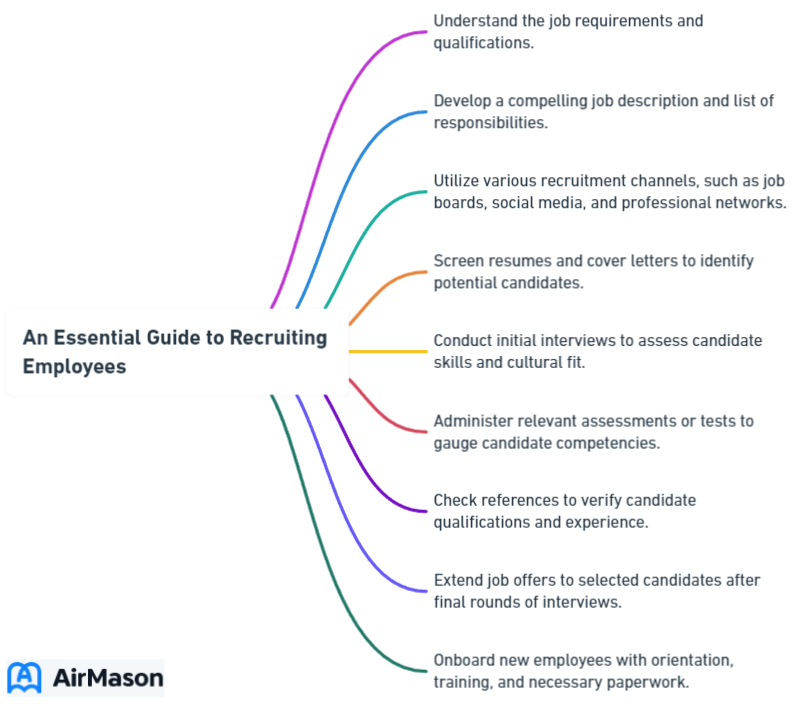
In the ever-evolving landscape of 2024, recruiting the right talent is more crucial than ever. With various channels, strategies, and technologies at our disposal, we must adapt our approach to stay competitive and secure top candidates. Are you ready to redefine your recruitment process and build a winning team? Let’s dive into the essential guide to recruiting employees in 2024, focusing on crafting compelling job descriptions, leveraging technology, conducting effective interviews, and more to ensure success in attracting and retaining the best talent!
Key Takeaways
- Develop a comprehensive recruitment strategy that aligns with company culture and values, utilizes multiple channels to reach diverse talent pool.
- Prepare structured interview questions involving team members to evaluate cultural fit.
- Invest in onboarding plan, monitor progress & provide training/mentorship for employee growth and development.
Employee Definition
In the realm of business and organizational dynamics, the term “employee definition” holds paramount significance. The employee definition encapsulates the formal identification and classification of individuals engaged in a professional capacity within a company or entity. It encompasses a comprehensive understanding of the roles, responsibilities, and legal parameters that define the employer-employee relationship. Employers often turn to the employee definition to establish a clear framework for hiring, compensation, benefits, and overall workforce management. As organizations navigate the intricacies of modern employment, a well-defined employee definition becomes the cornerstone for fostering a productive and legally compliant work environment.
Developing a Successful Recruitment Strategy
A successful recruitment strategy is the backbone of your hiring process. It involves:
- Defining objectives
- Aligning with company culture and values
- Utilizing multiple channels such as job boards, social media, and employee referral programs to reach a diverse pool of candidates.
A comprehensive and effective recruitment strategy is key to attracting and retaining top talent in a competitive job market, which in turn, leads to increased employee satisfaction and performance. To recruit employees successfully, it’s crucial to develop and implement a well-thought-out strategy.

Define your objectives
Setting clear and achievable hiring objectives is the first step in constructing a successful recruitment strategy. Objectives can range from:
- Refining the quality of candidates
- Creating a pool of qualified applicants
- Accelerating the hiring process
- Enhancing recruitment marketing efforts
Once hiring objectives are defined, the recruitment process can be streamlined, focusing on the right skills and experience for each role.
Remember, well-defined objectives lead to measurable results and continuous improvement in your hiring strategy.
Align with company culture and values
Aligning your recruitment strategy with your company’s culture and values is critical for attracting the right candidates who will thrive in your organization. Showcasing your company’s mission, values, and culture throughout the recruitment process draws in candidates who resonate with your organization’s ethos. Some strategies include communicating your values and goals, creating a strong employer brand, and assessing candidates for compatibility with your company culture.
Ultimately, hiring candidates who align with your company culture leads to improved employee satisfaction, performance, and retention.
Utilize multiple channels
In today’s competitive job market, leveraging multiple channels is essential for reaching a diverse pool of candidates. Job boards, social media platforms, and employee referral programs are just a few examples of the avenues you can use to share job openings and attract top talent. Tapping into various channels increases the chances of reaching both active and passive job seekers, expanding the talent pool and improving the overall quality of candidates.
Don’t limit yourself to just one channel – explore all your options and maximize your recruiting efforts.
Crafting Compelling Job Descriptions

Crafting compelling job descriptions is crucial for attracting qualified candidates. A well-written job description provides a clear picture of the role, its responsibilities, requirements, and the company culture. It serves as the first point of contact between your organization and potential candidates, making it essential to create an engaging and informative job post.
To craft a compelling job description, make sure to include essential information, use relevant keywords, and highlight growth opportunities within your organization. Remember, a great job description is the foundation of a successful recruitment process.
Include essential information
Providing essential information in your job description is critical for setting clear expectations and attracting the right candidates. This includes detailing the job responsibilities, requirements, and benefits associated with the role. Ensure you provide a realistic portrayal of the job and include key responsibilities and functions, as this will help candidates understand what is expected of them.
Giving candidates a comprehensive understanding of the role improves the chances of attracting candidates who are genuinely interested and qualified for the position.
Use relevant keywords
Using relevant keywords in your job descriptions can significantly improve their visibility and reach. Think about the terms job seekers are likely to search for when looking for a job in your industry, and incorporate those keywords into your job postings. This will improve the chances of your job posting appearing in search engine results, making it more likely to be seen by potential candidates.
Additionally, using relevant keywords can help attract candidates with the right skills and experience, ensuring that your recruitment efforts are targeted and effective.
Highlight growth opportunities
Emphasizing growth opportunities within your organization is a powerful way to attract ambitious job candidates seeking career advancement. In your job descriptions, make sure to highlight the potential for professional growth, such as involvement in professional organizations, networking events, and leadership development programs.
By showcasing the growth potential within your company, you can entice top talent who are not only looking for a job but a fulfilling career with opportunities for personal and professional development.
Leveraging Technology in the Hiring Process

Technology plays a significant role in the hiring process, helping to streamline tasks, improve efficiency, and reach a wider pool of candidates. Utilizing tools such as applicant tracking systems (ATS), social media recruiting, and AI-driven candidate screening can greatly enhance your recruitment efforts and ensure that you attract the best talent in the market.
Staying up-to-date with the latest technology trends and incorporating them into the hiring strategy can optimize your recruitment process and stay ahead of the competition.
Employee or Employees
In any organization, understanding the needs and motivations of the workforce is crucial for fostering a positive and productive work environment. Clear communication of roles, responsibilities, and expectations is vital to ensure that both the employee or employees and the employer are on the same page. Establishing a transparent framework for employee or employees’ expectations helps create a supportive atmosphere, enhancing job satisfaction and overall performance. Regular feedback and open dialogue further contribute to aligning organizational goals with the expectations of the workforce, promoting a harmonious and mutually beneficial relationship.
Applicant tracking systems (ATS)
Applicant tracking systems (ATS) are an invaluable tool for managing and organizing candidate information throughout the recruitment process. These systems automate tasks such as scanning resumes and sorting applicants, making it easier for recruiters and hiring managers to track candidates’ progress and ensure a smooth hiring process. Using an ATS can centralize candidate data, streamline recruitment efforts, and ultimately leads to more informed hiring decisions.
Choose an ATS that best fits your organization’s needs and watch your recruitment process become more efficient and effective.
Social media recruiting
Social media platforms have become a powerful tool for recruitment, allowing companies to showcase their culture, engage with potential candidates, and share job openings with a wider audience. Platforms such as LinkedIn, Facebook, and Twitter can be used to post job ads, share company news, and interact with job seekers.
Leveraging social media in the recruitment strategy can have several benefits, including:
- Reaching more candidates
- Creating a strong employer brand that attracts top talent
- Maintaining an active presence on social media
- Engaging with job seekers
By following these strategies, you can maximize the benefits of social media as a powerful recruiting tool.
AI-driven candidate screening
AI-driven candidate screening tools can significantly speed up the process of identifying qualified applicants and reduce the time spent on manual screening. Implementing these tools in the recruitment process quickly filters out unqualified candidates and focuses efforts on those most likely to be a good fit for the organization. This not only saves time and resources but also ensures that your recruitment process is efficient and effective.
Embrace AI-driven candidate screening tools and watch your recruitment efforts become more streamlined and successful.
Conducting Effective Interviews

Conducting effective interviews is a critical component of the hiring process. Preparing structured questions, involving team members, and evaluating cultural fit provides valuable insights into a candidate’s qualifications, personality, and potential fit within the organization.
A well-executed interview can make all the difference in selecting the right candidate for the job, ensuring that you hire individuals who will contribute positively to your team and organization. Remember, a successful interview is the key to making informed and confident hiring decisions.
Prepare structured interview questions

Developing structured interview questions is vital for ensuring consistency and fairness in the evaluation of candidates. Using competency-based questions that focus on past experiences and behaviors effectively gauges a candidate’s ability to perform the job and assesses their potential for success. Make sure to use the STAR method (Situation, Task, Action, Result) to structure your questions and guide the candidate’s response.
This will enable you to objectively evaluate each candidate and make informed decisions based on their interview performance.
Involve team members
Involving team members in the interview process can provide diverse perspectives and insights on candidate fit. Including team members in the evaluation process gains a more comprehensive understanding of how a candidate will interact with existing team members and contribute to the overall team dynamic. This collaborative approach not only ensures that you hire candidates who are a good fit for your organization but also fosters a sense of ownership and engagement among team members.
Collaborate with your team and make better hiring decisions together.
Evaluate cultural fit
Assessing a candidate’s cultural fit is essential for ensuring that they align with your company’s values and will contribute positively to the team dynamic. During the interview process, focus on evaluating the candidate’s work background, communication style, and ability to adapt to your company culture.
By considering this information alongside the candidate’s skills and qualifications, you can make more informed hiring decisions and ensure that you hire individuals who are not only capable but also a great fit for your organization. Remember, a strong cultural fit leads to increased employee satisfaction and performance.
Post-Interview Steps

Once the interviews are completed, it’s crucial to follow a structured post-interview process to ensure you make the best hiring decision. This includes:
- Conducting reference and background checks
- Comparing and ranking candidates based on their qualifications and overall fit with the organization
- Making a competitive job offer
Following these steps in the recruiting process increases the chances of securing top talent and minimizes the risk of making a poor hiring decision. Remember, the post-interview process is just as important as the interview itself in ensuring a successful hire.
Conduct reference and background checks
Performing reference and background checks is essential for verifying candidate information and ensuring a safe and secure workplace. These checks offer assurance to your team by confirming the applicant’s employment history and guaranteeing that they do not have any careless or dubious activity on their records that could pose a risk to your organization.
Dedicating time and resources to this crucial step in the hiring process minimizes the risk of negligent hiring, legal action, and potential harm to the organization’s reputation.
Compare and rank candidates
Comparing and ranking candidates based on their qualifications, interview performance, and overall fit with the organization is a critical step in the hiring process. Objectively evaluating each candidate ensures informed decisions and hires the most suitable individuals for the team.
Utilize tools such as candidate scorecards or rating scales to quantify and compare candidate performance during the interview process. This will allow you to make more accurate and fair assessments of each candidate and ultimately result in better hiring decisions.
Make a competitive job offer
In the competitive job market of 2024, making a competitive job offer is crucial for securing top talent. This includes offering an attractive salary, comprehensive benefits package, and growth opportunities within your organization. Presenting a compelling job offer improves the chances of attracting and retaining the best candidates, leading to a more successful and productive team.
Keep in mind that a competitive job offer not only benefits your organization but also contributes to the overall satisfaction and well-being of your existing employees.
Onboarding and Retaining New Hires

Once you’ve successfully recruited and hired new employees, it’s crucial to focus on onboarding and retaining them. This involves developing a comprehensive onboarding plan, monitoring new hire progress, and encouraging employee growth and development. Dedicating time and resources to these efforts ensures that new hires feel welcomed, supported, and motivated to perform at their best.
Remember, a successful onboarding process not only promotes employee satisfaction and performance but also contributes to the long-term success of your organization.
Develop a comprehensive onboarding plan
Creating a thorough onboarding plan is essential for helping new hires acclimate to their roles and the company culture. This includes introducing them to the organization, reviewing the job role and expectations, and providing them with any necessary resources and training.
A comprehensive onboarding plan ensures that new employees are set up for success from day one, allowing them to quickly start delivering positive results and contributing to the team. Invest in a well-designed onboarding plan and watch your new hires flourish in their roles.
Monitor new hire progress
Monitoring new hire progress is essential for identifying areas for improvement and providing support as needed. Regular check-ins, feedback from colleagues, and performance reviews can help you assess how well your new hires are adapting to their roles and the organization’s culture. Providing ongoing support and feedback is crucial to ensuring that your new employees continue to grow and develop in their roles.
Staying engaged and attentive to their progress creates a supportive and nurturing environment that fosters employee satisfaction and success.
Encourage employee growth and development
Encouraging employee growth and development is vital for maintaining a motivated and high-performing workforce. By providing opportunities for training, mentorship, and career advancement, you can help your employees reach their full potential and contribute to the success of your organization. This not only benefits your employees but also strengthens your company’s reputation as a supportive and forward-thinking employer.
Invest in your employees’ growth and development, and watch your organization thrive.
Summary
In conclusion, recruiting employees in 2024 requires a comprehensive and strategic approach, encompassing crafting compelling job descriptions, leveraging technology, conducting effective interviews, and focusing on onboarding and retention. By implementing these strategies, you can attract and retain top talent, resulting in a more successful and productive team. As the job market continues to evolve, staying ahead of the curve and adapting your recruitment process to meet the changing needs of candidates and the industry will be essential for your organization’s success. Embrace these strategies and secure the best talent for your organization in 2024 and beyond.
Frequently Asked Questions
What is recruiting employees?
Recruitment is the process of identifying, attracting, interviewing, selecting, hiring and onboarding employees in order to fill job vacancies or staff for growth. This involves finding the best candidate for the role, taking them through the entire hiring process from inception to integration into the company.
What are the 5 recruitment strategies?
Recruiting top talent requires creating a candidate persona, ensuring a seamless experience, developing an employee referral program, reducing bias and understanding what talent wants.
What is staffing vs recruiting?
Staffing and recruiting services have distinct differences – while staffing services provide temporary or contract employees as needed, recruiting services are focused on finding permanent staff for an organization. Both can be important to ensuring an organization’s success.
Is recruiting an HR role?
Recruiting is an essential part of HR as it provides the organization with qualified job candidates to choose from. Employers generally use a combination of internal and external recruitment tactics. It is a distinct role that requires its own skillset, separate from that of HR personnel.
What are some effective ways to align a recruitment strategy with company culture and values?
To effectively align a recruitment strategy with company culture and values, communicate and discuss values with candidates, create communities of practice to demonstrate values, and promote diversity and inclusion in recruitment practices.